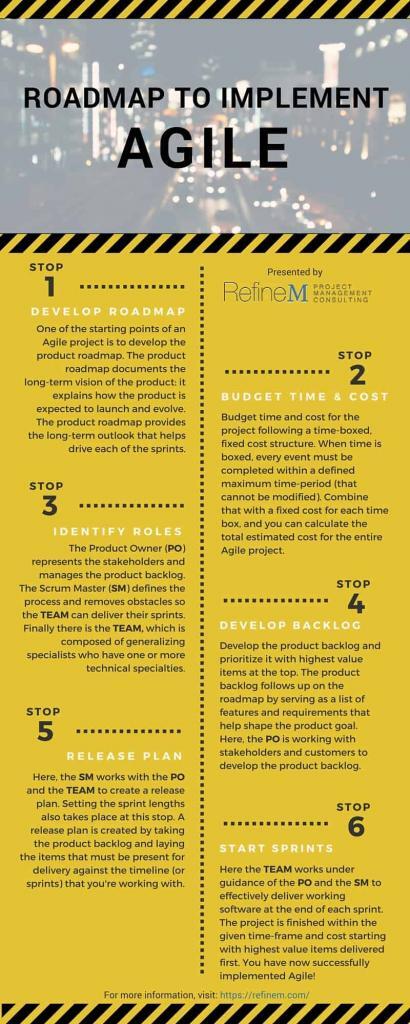Roadmap to Implement Agile
/*Roadmap to Implement Agile

Are you ready to have a team that is actively involved, quick to make decisions and quick to embrace change? If so, you’re ready to implement Agile. With Agile, you’ll speed up delivery, have higher customer satisfaction, greater project success, and will be better equipped to reduce risk. Follow us on the road to implement Agile.
We’ve created an infographic that you can easily save and look back to when implementing Agile:

6 Stops on the Roadmap to Implement Agile:
- Develop the Product Roadmap. One of the starting points of an Agile project is to develop the product roadmap. The product roadmap documents the long-term vision of the product: it explains how the product is expected to launch and evolve. The product roadmap provides the long-term outlook that helps drive each of the sprints.
- Budget Time and Cost. Budget time and cost for the project following a time-boxed, fixed cost structure. When time is boxed, every event must be completed within a defined maximum time-period (that cannot be modified). Combine that with a fixed cost for each time box, and you can calculate the total estimated cost for the entire Agile project.
- Identify Roles. The Product Owner represents the stakeholders and manages the product backlog. The Scrum Master defines the process and removes obstacles so the team can deliver their sprints. Finally there is the team, which is composed of generalizing specialists who have one or more technical specialties.
- Develop the Product Backlog. Develop the product backlog and prioritize it with highest value items at the top. The product backlog follows up on the product roadmap by serving as a list of features and requirements that help shape the product goal. Here, the Product Owner is working with stakeholders and customers to develop the product backlog.
- Create a Release Plan. Here, the Scrum Master works with the Product Owner and the team to create a release plan. Setting the sprint length also takes place at this stop. A release plan is created by taking the product backlog and laying the items that must be present for delivery against the timeline (or sprints) that you’re working with.
- Start Sprints. At this point, the team works under guidance of the Product Owner and the Scrum Master to effectively deliver working software at the end of each sprint. The project is finished within the given time-frame and cost starting with highest value items delivered first. You have now successfully implemented Agile!
By following these steps, you should be able to implement Agile. However, once Agile is implemented, you need to make sure that your processes are in place to ensure success throughout.
Are you looking for a way to measure your organization’s Agile maturity? RefineM offers a free Agility Assessment. Get your results emailed within 5 minutes.